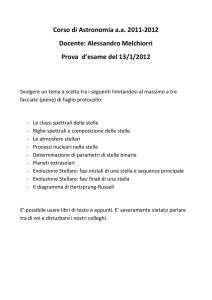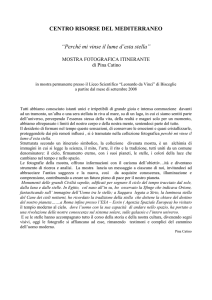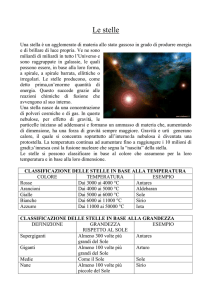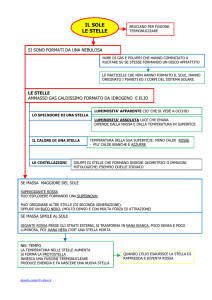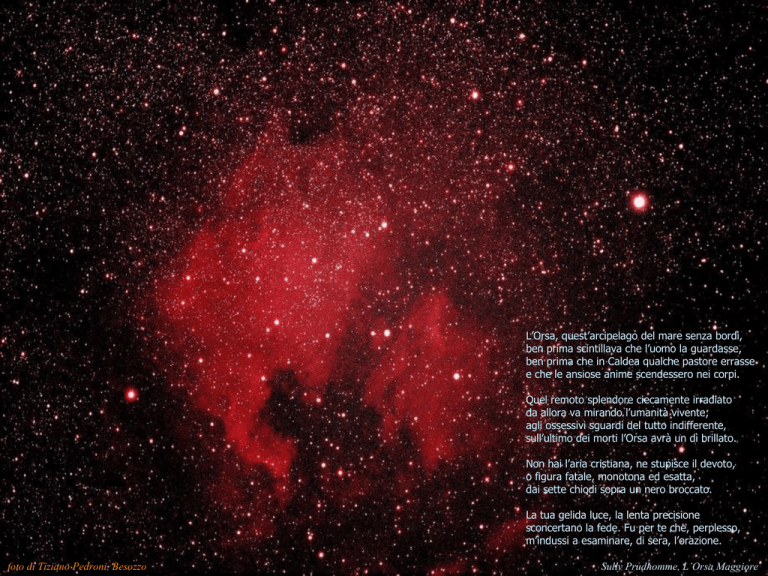
L’Orsa, quest’arcipelago del mare senza bordi,
ben prima scintillava che l’uomo la guardasse,
ben prima che in Caldea qualche pastore errasse
e che le ansiose anime scendessero nei corpi.
Quel remoto splendore ciecamente irradiato
da allora va mirando l’umanità vivente;
agli ossessivi sguardi del tutto indifferente,
sull’ultimo dei morti l’Orsa avrà un dì brillato.
Non hai l’aria cristiana, ne stupisce il devoto,
o figura fatale, monotona ed esatta,
dai sette chiodi sopra un nero broccato.
La tua gelida luce, la lenta precisione
sconcertano la fede. Fu per te che, perplesso,
m’indussi a esaminare, di sera, l’orazione.
foto di Tiziano Pedroni, Besozzo
Sully Prudhomme, L’Orsa Maggiore
astrofisica
stelle
appunti di fisica
per la quinta g
Rev. mag-09
Sommario
■
Parte 1: Stelle
• I dati osservativi
• L’evoluzione delle stelle
In files separati:
Parte 0: Storia astronomia
Parte 2: Galassie
Parte 3: Cosmologia (con Bibliografia)
3
I dati osservativi
■
Luminosità apparente I [W/m2]
• E’ fisicamente una intensità
■
■
■
■
Occhio nudo: 2000 stelle
Binocolo: 50.000
Piccolo telescopio: 100.000
Fotografate: 1010
• Antichità: 6 classi, da I a VI grandezza
(I = massima luminosità)
• Oggi: Magnitudine apparente m
(grande m, piccola luminosità)
m=m Vega−2.5 Log
In acustica : S =10 Log
I
I0
I
I Vega
S ( I 0)=0
4
I dati osservativi
■
Distanza [ly, pc]
Per stelle vicine, entro galassia (*):
• metodo trigonometrico della parallasse
■
Stella più vicina: Alfa Centauri, d = 4 1016 m = 4.3 ly
■
■
■
1 ly (anno luce) = 9.45 1015 m
1 pc (parsec) = 3.26 ly = 3.08 1016 m
Funziona (*):
– fino a circa 0.01” (326 ly) per osservazioni da Terra
– fino a circa 0.001” da satellite (3260 ly)
d=
r
r
≃
=
tan p p rad
r
(
psec 3.14
)(
)
3600 180
PARALL[1].gif
• Metodo di Hubble: d=v/H
• Per stelle lontane: metodo delle Cefeidi (cfr. oltre)
* Raggio disco galattico 50000 ly; Sole a 32000 ly dal centro.
5
I dati osservativi
■
Luminosità assoluta L [W]
I=
L
4π d 2
L = 4π d 2 I
• Fisicamente è la potenza erogata
• LAlfa Centauri = 4 1026 W ≈ L
• Range (L): 10 – 10 L
-4
4
■
Temperatura in superficie, T [K]
• Legge di spostamento di Wien:
λ max T = 0.003 m K
• T = 5800 K
• Range (T): 2000 – 20000 K
6
I dati osservativi
■
Raggio
• Legge di Stefan – Boltzmann:
■
■
■
Potenza emessa Pe da superficie emittente A a temperatura T con coefficiente di
emissione e: Pe = σAeT4 W
(σ = 5.67 10-8 W m-2 K-4)
Intensità emessa Ie per unità di superficie da un corpo nero (stella) a temperatura T:
Ie = σT4 W /m2
R = 0.7 10 km
6
L
4
=
σ
T
4π R 2
L
Θ 2 = σ TΘ4
4π RΘ
TΘ2
R = RΘ 2
T
L R2 T 4
= 2 4
LΘ RΘ TΘ
L
LΘ
7
I dati osservativi
■
Tipo B
Composizione chimica
•
Analisi righe sovrapposte allo
spettro continuo
•
Principalmente H
Sole: tipo spettrale G2
8
I dati osservativi
Dagli spettri ottenuti
con gli spettrografi
accoppiati ai telescopi
Si possono classificare le stelle in base al
tipo spettrale (O, B, A, F, G, K, M) ed alla
luminosità apparente (oppure alla
Magnitudine assoluta M, la magnitudine
riportata a 10 pc di distanza)
M = m-2.5 Log I/I0 = m-2.5 Log d02/d2
M = m + 5 - 5 Log d
9
Stella
Quasar
Galassia
10
I dati osservativi
■
Diagramma H-R
• Hertzsprung-Russell, 1913
• Luminosità (o magnitudine assoluta)
vs. temperatura (o λ)
11
I dati osservativi
■
Massa M [M]
• M con III Keplero
T2
4π 2
=
R 3 GM Θ
4π 2 R 3
MΘ =
G T2
• Clark (USA, 1842) osserva compagna oscura di Sirio.
• Generalizzando III Keplero per 2 corpi con masse dello stesso
ordine MA e MB:
T2
4π 2
=
( RA + RB )3 G ( M A + M B )
■
Se MA>>MB: MB=0, RA=0 e si ha Keplero
• Si trovano solo M di 102 stelle vicine
• Per le altre in sequenza principale:
L = M 3.5
■
L misurata in L, M in M
■
vale solo in zona centrale
• M = 2 10 30 kg
• Range (M): 10 -2 – 10 2 M
12
■
Densità ρ delle stelle [kg/m3]
Gigante Rossa: nucleo denso, e strati
esterni espansi, 10-3 kg/m3 (1/1000 di ρ
aria)
Sole: 1,4 x 104 kg/m3 (1/4 della densità
della Terra)
Nana Bianca: > 1010 kg/m3
Stella di Neutroni: 1015 - 1018 kg/m3
Buco nero: > 1020 kg/m3
13
14
15
L’evoluzione
delle stelle
16
La Nebulosa dell’Aquila
■
These eerie, dark pillar-like structures are actually columns of cool interstellar hydrogen gas and dust that
are also incubators for new stars. The pillars protrude from the interior wall of a dark molecular cloud like
stalagmites from the floor of a cavern. They are part of the Eagle Nebula (also called M16, the 16th object
in Charles Messier's 18th century catalog of "fuzzy" objects that aren't comets), a nearby star-forming region
7,000 light-years away in the constellation Serpens.
The pillars are in some ways akin to buttes in the desert, where basalt and other dense rock have protected
a region from erosion, while the surrounding landscape has been worn away over millennia. In this celestial
case, it is especially dense clouds of molecular hydrogen gas (two atoms of hydrogen in each molecule) and
dust that have survived longer than their surroundings in the face of a flood of ultraviolet light from hot,
massive newborn stars (off the top edge of the picture). This process is called photoevaporation.
This ultraviolet light is also responsible for illuminating the convoluted surfaces of the columns and the
ghostly streamers of gas boiling away from their surfaces, producing the dramatic visual effects that
highlight the three-dimensional nature of the clouds. The tallest pillar (left) is about a light-year long from
base to tip.
As the pillars themselves are slowly eroded away by the ultraviolet light, small globules of even denser gas
buried within the pillars are uncovered. These globules have been dubbed EGGs. EGGs is an acronym for
Evaporating Gaseous Globules, but it is also a word that describes what these objects are. Forming
inside at least some of the EGGs are embryonic stars, stars that abruptly stop growing when the EGGs are
uncovered and they are separated from the larger reservoir of gas from which they were drawing mass.
Eventually, the stars themselves emerge from the EGGs as the EGGs themselves succumb to
photoevaporation.
The picture was taken on April 1, 1995 with the Hubble Space Telescope Wide Field and Planetary Camera 2.
The color image is constructed from three separate images taken in the light of emission from different
types of atoms. Red shows emission from singly-ionized sulfur atoms. Green shows emission from
17
hydrogen. Blue shows light emitted by doubly- ionized oxygen atoms.
Evoluzione stellare
■
Condizione necessaria per formazione delle stelle
• In Lab una nube di gas si espande; nell’universo si contrae.
EK , molecola =
3
kT
2
E fuga , gravit . =
1 2
Mm
mvF = G
2
R
– con M, R della nube e m della molecola che dista R dal centro
• La condizione perché si contragga e si formi una stella è
(utilizzando la densità in luogo della massa M della nube):
3
Mm
kT < G
2
R
T<
2GMm
3kR
R>
9 kT
8π Gmρ
18
Evoluzione stellare
■
Esempi
3
Mm
kT < G
2
R
R>
9 kT
8π Gmρ
T<
2GMm
3kR
• N2 atmosferico (ρ=1.3, T=293), R = 2 107 m = 20000 km
Con raggio minore non si può formare una “stella”
• H interstellare (ρ=10-20, T=100), R = 6.7 1017 m = 70 ly, con una
massa della nube di 1.3 1034 kg = 6300 M
Con questa massa si forma un insieme di stelle
■
In sequenza principale:
• La contrazione dura alcuni My.
• Il gas si scalda per urti: EK di contrazione si trasforma in T.
T cresce fino a soglia delle reazioni nucleari.
• La contrazione si arresta: è nata una stella.
• Se M < 10-2 M non si hanno reazioni, la stella si raffredda fino a
diventare un corpo simile a Giove (nana nera)
19
Evoluzione stellare
20
Evoluzione stellare
■
■
Stelle fredde, prevale ciclo p – p
H 2 + e+ + ν e
•
p+p
•
•
p + H2
He3 + γ
He3 + He3 He4 + 2p
■ 4p He4 + 2e+ + 2ν + γ
e
Stelle calde, prevale ciclo C – N
• C12 + p C13 + e+ + νe + γ
• C13 + p N14 + γ
• N14 + p O15 + γ
• O15 N15 + e+ + νe
• N15 + p C12 + He4 + γ
■
4p He4 + 2e+ + 2νe + γ
21
H
Evoluzione stellare
Alta T
■
Fusione
Esempi
• Sole
■
■
■
■
E
T interna uguale a 2.3 107 K
Brucia 6.7 1011 kg/s di H
Dal difetto di massa si ha una potenza
prodotta di:
4.9 109 kg/s = 4 1026 W
La combustione può durare 10 Gy.
• Stelle giganti
■
■
Stella con M=50 M ha L=105 L
ed è attiva per 1 My
Le stelle massicce sono giovani,
dunque nell’universo continuano a
formarsi stelle.
22
In sequenza principale
T >107 K: Sistema stabile
P verso l’esterno
(energia nucleare)
P verso l’interno
(contrazione
gravitazionale)
STABILITA’
23
Struttura interna del Sole
H
Nucleo di Elio
He
H He
Shell di Idrogeno in
cui ha ancora luogo la
fusione H He
Strati esterni più
freddi di Idrogeno
24
Struttura interna del Sole
Il nucleo contiene
quasi la metà della
massa solare, in
solo il 2% del
volume.
Lì avvengono le
reazioni nucleari
H → He
25
• 108 K: Combustione di He
■
Evoluzione stellare
• Quando il 10% di H è bruciato,
R cresce e la stella diventa una
gigante rossa.
■
• 5 108 K: Combustione di C
■
■
■
• Combustione di He fino a Fe (più
stabile).
C12 + C12 Mg24 + γ
C12 + C12 Na23 + p
C12 + C12 Ne20 + α
• 109 K: Combustione di O
■
• Di seguito alcuni esempi di
fusioni.
3 He4 C12 + γ
C12 + He4 O16 + γ
■
■
■
O16 + O16 S32 + γ
O16 + O16 P31 + p
O16 + O16 S31 + n
O16 + O16 Si28 + α
• 2 109 K: Combustione di Si
■
■
■
■
■
Si28 + γ 7 He4
Si28 + 7 He4 Ni56
Si28 + Si28 Ni56
Ni56 Co56 + e+ + νe
Co56 Fe56 + e+ + νe
26
Sole nel “Braccio
Orizzontale”
(combustione He C)
Sole Supergigante Rossa
(innesco He C)
Sole nel ramo delle
Giganti rosse: 100 My
(contrazione gravitazionale)
H He
Formula reazione:
4 H 4He + γ
T innesco: circa 107 K
He C
Formula reazione:
3 4He 12C + γ
T innesco: circa 108 K
Sole in sequenza
Principale: 10 Gy
(H He)
27
T fusione 12C:
8 x 108 K
Fase successiva al
“Braccio Orizzontale”:
Elio Esaurito
Contrazione gravitazionale
Sole nel “Braccio
Orizzontale”: 1 Gy
(combustione He C)
Sole in sequenza
Principale: 10 Gy
(H He)
28
29
30
31
32
Evoluzione del Sole
Gigante Rossa
Braccio orizzontale
Nana Bianca
Sequenza Principale
33
34
Evoluzione stellare
• Struttura di una stella
di circa 15 Masse solari
subito dopo la fase di
fusione 56Ni 56Fe
• Nucleo: 56Fe
• T nucleo: 5-10 ⋅ 109 K
35
Evoluzione stellare
Nel BB si sono formati solo 4He, tracce di: D, 3He, e ancor meno: Li, Be.
Perché gli elementi più pesanti non si sono formati nel Big Bang caldo?
Valori iniziali a t ≈ 0 del
BB caldo: T ≈ 1013 K
ρ ≈ 1017 kg/m3
Durante i primi 3 minuti:
calo continuo di T e ρ
Anche nelle stelle le reazioni di fusione hanno una probabilità
Lebassa
reazioni
nucleari che
sappiamo
essere
efficienti
molto
di avvenire,
e tale
probabilità
dipende
dalla
nelle stelle,
temperatura
delnon
gas.potevano esserlo durante la prima fase
big bang, poiché
hanno
chesufficientemente
la temperatura
Se ladel
temperatura
resta alta
perbisogno
un tempo
delallora
gas resti
alta per sufficientemente
un tempo molto lungo.
lungo,
un numero
alto di reazioni
soddisfatta
negli interni
stellari,
avràQuesta
luogo, condizione,
e darà origine
ad un numero
sufficientemente
lo era nei
primi minuti
dellabig
bang, poiché
la alta
alto non
di particelle
“pesanti”.
Ma se
temperatura
resta
temperatura
calava
velocemente
durante
l’espansione.
per un
tempo troppo
corto,
si potranno
formare
solo
pochissimi elementi pesanti.
36
La fase finale
■
Nane bianche
•
Gli atomi sono mantenuti integri, ma
occupano uno spazio ridotto
•
Gli e- hanno poco spazio
Per De Broglie (λ=h/p) hanno
maggiori p e Ek
•
•
•
Nana bianca:
Materia degenere
La pressione che si produce contrasta
la gravitazione e crea un nuovo
equilibrio che non richiede alte T (è
un effetto quantistico)
Stabili con masse inferiori a 1.44 M
(massa di Chandrasekhar, 3·1030 kg)
oltre la quale la pressione non ferma il
collasso.
37
Materia degenere
Imagine that there is a plasma, and it is cooled and compressed repeatedly. Eventually, we will not be able to compress the plasma any
further, because the Exclusion Principle states that two particles cannot be in the exact same place at the exact same time. When in this
state, since there is no extra space for any particles, we can also say that a particle's location is extremely defined. Therefore, since
(according to the Heisenberg Uncertainty Principle)
Principle) ∆x ∆p = h/4π, then we must say that their momentum is extremely uncertain since the
molecules are located in a very confined space. Therefore, even though the plasma is cold, the molecules must be moving very fast on
average. This leads to the conclusion that if you want to compress an object into a very small space, you must use tremendous force to
control its particles' momentum.
Unlike a classical ideal gas, whose pressure is proportional to its temperature (PV
(PV = NkT),
NkT), the pressure exerted by degenerate matter
depends only weakly on its temperature.
temperature. In particular, the pressure remains nonzero even at absolute zero temperature. At relatively low
densities, the pressure of a fully degenerate gas is given by P = Kn5/3, where K depends on the properties of the particles making up the gas.
At very high densities, where most of the particles are forced into quantum states with relativistic energies, the pressure is given by
P = K'n4/3, where K' again depends on the properties of the particles making up the gas.
Degenerate matter still has normal thermal pressure, but at high densities the degeneracy pressure dominates.
dominates. Thus, increasing the
temperature of degenerate matter has a minor effect on total pressure until the temperature rises so high that thermal pressure again
dominates total pressure.
Exotic examples of degenerate matter include neutronium, strange matter, metallic hydrogen and white dwarf matter. Degeneracy pressure
contributes to the pressure of conventional solids, but these are not usually considered to be degenerate matter as a significant contribution to
their pressure is provided by the interplay between the electrical repulsion of atomic nuclei and the screening of nuclei from each other by
electrons allocated among the quantum states determined by the nuclear electrical potentials. In metals it is useful to treat the conduction
electrons alone as a degenerate, free electron gas while the majority of the electrons are regarded as occupying bound quantum states. This
contrasts with the case of the degenerate matter that forms the body of a white dwarf where all the electrons would be treated as occupying
free particle momentum states.
http://en.wikipedia.org/wiki/Degeneracy_pressure
38
Pressione
gas degenere
La fase finale
“Shell” o guscio di
Idrogeno
EQUILIBRIO
Contrazione
gravitazionale
“Shell” o guscio di Elio
Nucleo di Carbonio
39
La fase finale
Reazione di fotodisintegrazione di 56Fe
endoenergetica
Fe + γ 13 4He + 4n
56
Processo a catena in cui:
• più la reazione va avanti, più la stella perde energia, sia esternamente che,
questa volta, internamente;
• più perde energia, più si contrae;
• più si contrae, più aumenta l’efficienza della trasformazione del ferro e così la
stella si trova ad un certo momento con un pauroso ammanco di energia.
40
La fase finale
In meno di 1 secondo
Collasso gravitazionale
del nucleo
Onda d’urto che si propaga
verso l’esterno e nucleosintesi
esplosiva di elementi “pesanti”
Esplosione ed espulsione degli
strati esterni: v gas di circa
10.000 Km/sec
Residuo: Stella di neutroni
41
Type II SuperNova
Stars with at least nine solar masses of material evolve in a complex fashion. In the core of the star, hydrogen is fused into helium
and the thermal energy released creates an outward pressure, which maintains the core in hydrostatic equilibrium and prevents
collapse.
When the core's supply of hydrogen is exhausted, this outward pressure is no longer created. The core begins to collapse, causing a
rise in temperature and pressure which becomes great enough to ignite the helium and start a helium-to-carbon fusion cycle,
creating sufficient outward pressure to halt the collapse. The core expands and cools slightly, with a hydrogen-fusion outer layer,
and a hotter, higher pressure, helium-fusion center. (Other elements such as Ma,
Ma, S and Ca are also created and in some cases
burned in these further reactions.)
This process repeats several times, and each time the core collapses and the collapse is halted by the ignition of a further process
involving more massive nuclei and higher temperatures and pressures. Each layer is prevented from collapse by the heat and
outward pressure of the fusion process in the next layer inward; each layer also burns hotter and quicker than the previous one –
the final burn of silicon to nickel consumes its fuel in around one day, or a few days. The star becomes layered like an onion, with
the burning of more easily fused elements occurring in larger shells.
In the later stages, increasingly heavier elements undergo nuclear fusion, and the binding energy of the relevant nuclei increases.
Fusion produces progressively lower levels of energy, and also at higher core energies photodisintegration and electron capture
occur which cause energy loss in the core and a general acceleration of the fusion processes to maintain equilibrium. This
escalation culminates with the production of Ni56, which is unable to produce energy through fusion (but does produce Fe56
through radioactive decay). As a result, a nickel-iron core builds up that cannot produce any further outward pressure on a scale
needed to support the rest of the structure. It can only support the overlaying mass of the star through the degeneracy pressure of
electrons in the core. If the star is sufficiently large, then the iron-nickel core will eventually exceed the Chandrasekhar limit (1.38
solar masses), at which point this mechanism catastrophically fails. The forces holding atomic nuclei apart in the innermost layer
of the core suddenly give way, the core implodes due to its own mass, and no further fusion process can ignite or prevent collapse
this time.
42
Type II SuperNova
The core collapses in on itself with velocities reaching 70,000 km/s (0.23c), resulting in a rapid increase in temperature and density.
The energy loss processes operating in the core cease to be in equilibrium. Through photodisintegration, gamma rays decompose iron
into helium nuclei and free neutrons, absorbing energy, whilst electrons and protons merge via electron capture, producing neutrons and
electron neutrinos which escape.
In a typical Type II supernova, the newly formed neutron core has an initial temperature of about 100 GK; 6000 times the temperature
of the sun's core. Much of this thermal energy must be shed for a stable neutron star to form (otherwise the neutrons would "boil
away"), and this is accomplished by a further release of neutrinos. These 'thermal' neutrinos form as neutrino-antineutrino pairs of all
flavors, and total several times the number of electron-capture neutrinos. About 1046 joules of gravitational energy - approximately 10%
of the star's rest mass - is converted into a ten-second burst of neutrinos; the main output of the event. These carry away energy from
the core and accelerate the collapse, while some neutrinos may be later absorbed by the star's outer layers to provide energy to the
supernova explosion.
The inner core eventually reaches typically 30 km diameter, and a density comparable to that of an atomic nucleus, and further collapse
is abruptly stopped by strong force interactions and by degeneracy pressure of neutrons. The infalling matter, suddenly halted,
rebounds, producing a shock wave that propagates outward. Computer simulations indicate that this expanding shock does not directly
cause the supernova explosion; rather, it stalls within milliseconds in the outer core as energy is lost through the dissociation of heavy
elements, and a process that is not clearly understood is necessary to allow the outer layers of the core to reabsorb around 1044 joules of
energy, producing the visible explosion. Current research focuses upon a combination of neutrino reheating, rotational and magnetic
effects as the basis for this process.
When the progenitor star is below about 20 M (depending on the strength of the explosion and the amount of material that falls back),
the degenerate remnant of a core collapse is a neutron star. Above this mass the remnant collapses to form a black hole. (This type of
collapse is one of many candidate explanations for gamma ray bursts - producing a large burst of gamma rays through a still theoretical
hypernova explosion.) The theoretical limiting mass for this type of core collapse scenario was estimated around 40-50 M.
http://en.wikipedia.org/wiki/Supernova
43
Within a massive, evolved star (a) the onion-layered shells of elements undergo fusion, forming an iron core (b) that reaches
Chandrasekhar-mass and starts to collapse. The inner part of the core is compressed into neutrons (c), causing infalling material to
bounce (d) and form an outward-propagating shock front (red). The shock starts to stall (e), but it is re-invigorated by a process that
may include neutrino interaction. The surrounding material is blasted away (f), leaving only a degenerate remnant.
44
La fase finale
■ Stelle di neutroni
• Se M > 1.44 M il collasso non si ferma e gli
atomi scompaiono
• Decadimento beta inverso: e- + p → n + νe
• Grandi densità (nucleari), piccole λ, grandi p
• A 1017 kg m-3 la pressione di n può arrestare il
collasso per masse iniziali inferiori a 10 M
• Si può avere una stella di massa M con
raggio 10 km
• Si scopre un oggetto così piccolo perché forte
emettitore di radiazione di sincrotrone
■
■
■
■
Grande B (10 8 T)
Cariche elettriche con F Lorentz emettono ad
alta ν
Per rotazione stella (conservazione di L al
ridursi del raggio), il periodo è piccolissimo
(spesso minore di 1 s)
La radiazione di sincrotrone spazza l’universo
come un faro con la frequenza del moto di
rotazione (pulsar). È polarizzata, a differenza
della radiazione termica.
45
Una stella di neutroni possiede un’alta velocità di rotazione e un forte campo magnetico; quest’ultimo costringe gli elettroni a
seguire traiettorie elicoidali, con velocità prossime a quella della luce, intorno alle sue linee di forza.
Gli elettroni, accelerati in questo modo,
emettono “radiazione di sincrotrone”, che
ha la caratteristica di essere molto
concentrata, come un faro, all’interno di
un piccolo angolo intorno all’asse del
campo magnetico.
L'emissione della pulsar è analoga a quella
di un faro rotante in un porto: solo
quando l'osservatore si trova entro il cono
di luce può ricevere il segnale, e lo
riceverà quindi in impulsi distanziati di un
intervallo pari al periodo di rotazione del
faro.
Se l'asse magnetico non coincide con
quello di rotazione, il fascio di
particelle spazza un cono durante la
rotazione della stella.
Il periodo di rotazione di una pulsar è
destinato ad aumentare nel tempo: l'energia
irradiata, come luce e come onde
gravitazionali, va a scapito dell'energia
rotazionale e quindi la rotazione rallenta.
Tanto più è veloce la rotazione della pulsar
(pulsar del Granchio), tanto maggiore è il
rallentamento.
46
La fase finale
■
Buchi neri
• Se M > 10 M la pressione di neutroni non
basta e il collasso non si ferma più
• vfuga= c → R raggio di Schwarzschild
■
■
■
Orizzonte degli eventi o confine tra universi?
Se M = 10 M , R = 30 km
RTerra ≈ 1 cm
RSole = 3 km
Etot = EK + E pot = 0 ⇔ v = v fuga
1
2
v fuga =
(Terra e Sole non possono diventare buchi neri!)
• Si vedono nel caso di stelle doppie di cui
una è un buco nero
■
All’altra stella viene strappato gas che, a
velocità quasi pari a c e a T di 106 K, produce
un vortice di 100 km con forte emissione X
• Oppure come centri galattici
• Oppure per “radiazione di Hawking”
Mm
= 0
r
2GM
r
mv 2fuga − G
c=
2GM
R
RSchwarzschild =
2GM
c2
47
La fase finale
• La gravità deforma lo spazio-tempo attorno al buco nero creando una
singolarità
Black hole lensing
• Dall’interno nessun segnale
• Per comprendere l’interno la relatività generale non è più sufficiente: occorre
applicare la MQ allo spazio-tempo
■
Effetti nell’avvicinamento al raggio di Schwarzschild (per chi sta fermo
lontano):
• Dilatazione gravitazionale del tempo
■
■
orologi rallentano, a R il tempo si ferma
Il viaggio richiede un tempo infinito
• Il cono di radiazione emessa è sempre più stretto fino a chiudersi
• Red shift gravitazionale
■
Radiazione emessa sempre più spostata verso il rosso: λ→∞
• Gradiente di gravità sul corpo
■
Stiramento delle parti più vicine
48
La fase finale
■
Alla fine dell’evoluzione di una nebulosa protostellare:
• M < 10-2 M
■
Non si hanno reazioni nucleari (nana nera)
• 1 M < M < 2 M
■
Gigante rossa → Collasso fino a R di 10000 km (nana bianca)
• 2 M < M < 10 M
■
■
■
Supergigante → Esplosione di supernova: massa espulsa come nube
Una parte interna pari a circa M si contrae fino a R=10 km (stella di neutroni)
di
gas.
Esplosione in cui si formano i nuclei ad alto Z
Dal materiale si formano nuove stelle e pianeti
– La Terra è formata da materiale di una gigante rossa della prima generazione, esplosa.
• M > 10 M
■
Supergigante → Il collasso non si arresta (buco nero)
49
La fase finale
50
La fase finale
La fase finale
La fase finale
La fase finale
La fase finale
Stelle variabili
• Stelle pulsanti
■
■
■
■
L variano anche di 250 volte con periodi di
ore o anni
Contrazioni e dilatazioni
Es. Cefeidi: T varia di 1000 K, R del 20 %.
Relazione precisa tra periodo e L media
⇒ Metodo per misurare distanze stellari:
Periodo luminosità L Distanza d
56
Stelle variabili
• Variabili a eclisse
■
Doppie che si coprono
• Novae
■
■
■
■
Tipicamente da Nane bianche in sistemi binari, che assorbono H dalla
compagna, frequentemente una gigante rossa
Variazioni L intensissime (esplosioni)
R aumenta di 102
L aumenta di 103 – 105 per alcuni mesi o anni
• Supernovae
■
■
Esplosioni catastrofiche
L cresce di 106
57



